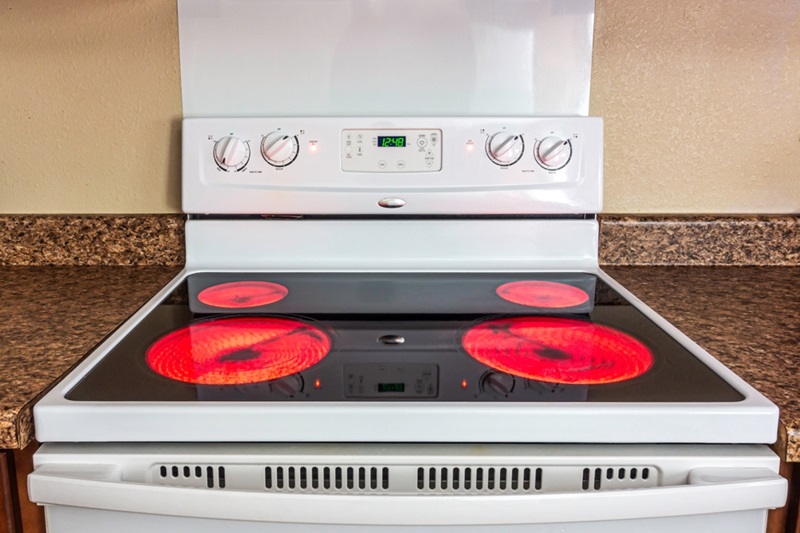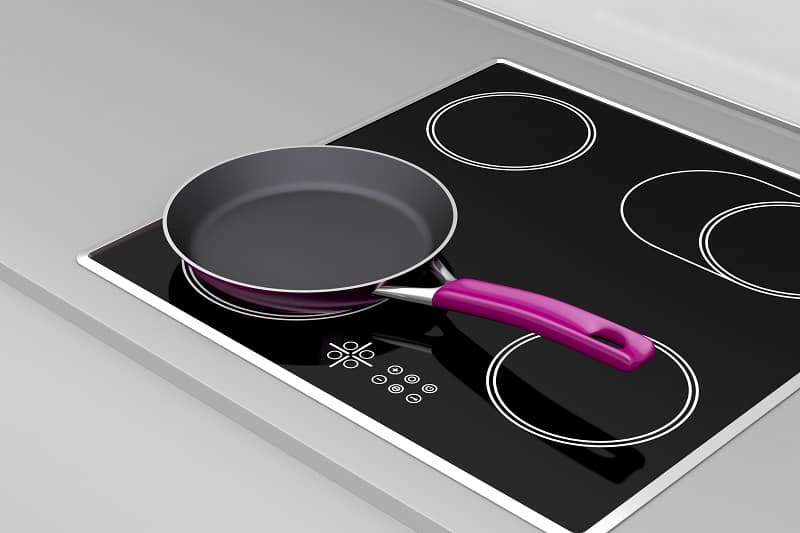Navigating the world of cooker hobs can be confusing. There are lots of different types available, all of which work slightly differently. In this article we’ll look at exactly what halogen hobs are, and their pros and cons compared to the alternatives.
What Is a Halogen Hob?
Halogen hobs are a type of electric hob that use infrared light to create heat. They are a specific type of ceramic hob, since they have a ceramic glass cooktop.
Unlike regular electric hobs, you don’t have to wait for them to heat up. They provide the same instant heat as gas, while still being powered by electricity. You can also turn the heat up and down instantly, like on a gas hob.
Halogen hobs use infrared radiation to heat pans. This is in contrast to other hob types that use thermal conduction or induction. Infrared radiation might sound dangerous, but halogen hobs are perfectly safe as long as you don’t stare at the infrared light.

How Do Halogen Hobs Work?
Halogen hobs transfer heat to a pot or pan through infrared radiation. This radiation works in a similar way to the ultraviolet radiation from the sun.
When the hob is turned on, the heat from the halogen tubes travels through the glass surface to reach the pot or pan. If there is no pan on the hob, the radiation will simply disperse into the room, heating up the surrounding area in a similar way to how a heater works.
Pros and Cons of Halogen Hobs
Like all types of hob, halogen hobs have a range of pros and cons that mean it may or may not be suitable for you. Here’s a summary of the advantages and disadvantages of halogen hobs versus other types of hob.
Pros
1. Low maintenance
The flat surface of a halogen hob means they need little to no maintenance and are very easy to clean. Where these hobs often have touch controls or slim buttons, there are no dials or knobs to get in the way. Once the hob has cooled down, it can simply be wiped over with a cloth.
2. Sleek design
Like most modern electric hobs, halogen hobs have a sleek, flat design that sits neatly in a worktop.
Temperatures
For most cooking enthusiasts, a gas hob is the gold-standard, especially when it comes to reaching very high temperatures for things like searing meat.
Whilst few hobs can compare to gas for this exact purpose, none come closer than halogen hobs. The fact these tubes can reach up to 700°C means they out-perform other types of electric hob.
Cons
1. Speed and efficiency
It is worth remembering that halogen hobs are not as fast or as efficient as either induction or gas hobs. This is mainly because of poor thermal conductivity rather than slow heating times.
This poor thermal conductivity is because infrared radiation is essentially hot light, which takes much longer to heat up a pan than gas, induction and electric hobs do.
2. Cool down times
When compared to other types of hobs, halogen hobs take much longer to cool down which can make them more of a safety concern after you have finished cooking. If you need your hob to cool down very quickly, you would be better off with an induction hob.
Cooking on a Halogen Hob
The first thing that you will notice upon turning on a halogen hob is the bright red light from the halogen tubes. The tubes emit both invisible and visible light, but it is the invisible infrared light that heats the food.
The red visible light simply gives you an indication of just how hot the ring is and how much cooking power it is emitting. The brighter the light, the greater the cooking power.
These tubes can give an enormous amount of cooking power (depending on the hob and settings), with anywhere from 150W to 2000W being possible. At their max, the tubes themselves can run at 700°C (or 1300°F).

Are Halogen Hobs the Same as Ceramic Hobs?
Whilst both ceramic and halogen hobs are electric hobs, there are some major differences between the two. The biggest difference between halogen and ceramic hobs is found in how the heat is generated. Halogen hobs rely on infrared radiation to cook food, whereas ceramic hobs have electric heating elements.
Halogen hobs typically have a ceramic glass surface that is incredibly durable that won’t end up damaged after regular use.
Ceramic hobs, on the other hand, have a sturdy glass surface that is designed to be incredibly durable. Where halogen hobs use tungsten-halogen tubes to generate heat, ceramic hobs have electric heating elements underneath the cooking zones.
Are Halogen Hobs the Same Induction Hobs?
If you search the internet for halogen hobs, you’ll find a lot of induction hobs instead. Does this mean that halogen and induction hobs are the same thing?
No, halogen hobs are not the same as induction hobs. Induction hobs use direct induction to heat pans, whereas halogen hobs use indirect radiation.
The confusion arises from the fact that both types of hob are electric ceramic hobs, so they look very similar. Many induction hobs also glow like halogen hobs, but this is just to show you that they are hot—they aren’t transmitting heat via infrared light.
Can You Still Buy Halogen Hobs?
Halogen hobs have been largely replaced by induction hobs, which most people consider to be superior. If you’re looking to replace an existing halogen hob, it might be worthwhile replacing it with an induction one instead.
Despite this, it is still possible to buy a halogen hob in the UK, however, they tend to be the single or double portable hot plates that are popular when camping or for use in very small kitchens.
They are often described as “infrared hobs” rather than halogen hobs, so try searching for that instead!
Here are a couple of halogen hobs you can buy in the UK.
CUSIMAX 2400W Double Infrared Hot Plate
At just 22.5 cm deep and 52.5 cm wide, this double infrared hot plate is the perfect solution if you are camping, don’t have the space in your kitchen for a full-size, fixed hob or sometimes just need extra burners.
Both cooking zones are rated for 1200W, and they are suitable for use with all types of cookware up to a diameter of 18 cm. This hot plate has non-slip feet for safety, and the rings have seven individual heat settings too.
CUSIMAX 1200W Single Infrared Hot Plate
This single infrared hotplate from Cusimax offers great flexibility. Its small size means it’s perfect if you need an extra burner, regardless of if you are cooking a large meal or just need to heat up a stovetop kettle somewhere more convenient. This hot plate heats up incredibly quickly, and it has a thermal fuse for added protection against overheating.

Chef’s Pick is your guide to the best kitchen equipment and appliances in the UK.
We help you understand the confusing world of cookers, ovens and cookware so you can get the most out of your kitchen.









